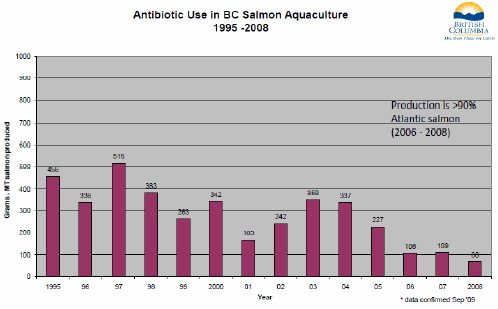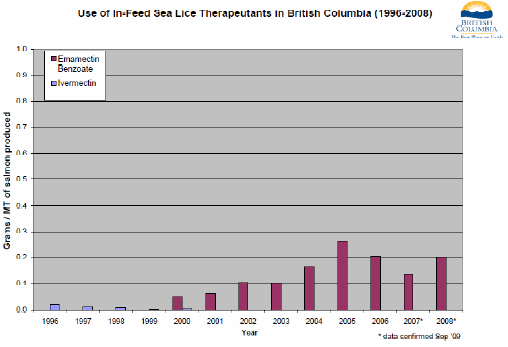Antibiotics:
Few drugs are available for use in food fish and all, if used, are applied by veterinary prescription in BC. Four (4) antibacterial products are licensed for finfish in Canada include: Terramycin Aqua® (oxytetracycline hydrochloride); Aquaflor® (florfenicol); Tribrissen® (trimethoprim and sulphadiazine); and Romet 30® (ormetoprim and sulphadimethoxine). Additional drug products are available at the discretion of attending veterinarians but their use is uncommon. Broodstock are occasionally medicated with other drugs if necessary and the brood may also receive injectable antibiotics; however, these fish are not destined for human consumption. BC feed mills abide by provincial regulations and report the use of antibiotics used in manufactured feeds but the use of injectable products in the brood is tracked by the prescribing veterinarian and by the farming companies.
As shown in Figure 1, the antibiotic use has ranged from a peak of 516 grams (g) of active drug per metric tonne (MT) of fish (1997) to an all-time low of 68 grams in 2008. It is noteworthy that these annual values (i.e. grams per metric tonne of fish produced) include the volume of antibiotics fed to broodstock (i.e. non-food fish); meaning that the main production fish, or ‘food fish’, are in reality exposed to lower amounts of antibiotic than the bar graph indicates.
Fish populations do not receive antibiotics in the absence of disease but medications are used to minimise, and to some extent mitigate, disease events that veterinarians recognise seasonally or arise following a stressor.

Sea Lice Medical Management:
Currently only one product is available for controlling sea lice in British Columbia: emamectin benzoate, commercially known under the trade name SLICE®. The in-feed therapeutant reached the formal status of a licensed and labelled drug following a thorough federal review and approval process under the authority of Health Canada. Emamectin benzoate is an efficacious drug for lice management, such that lice abundance on farms (in BC) typically remains low for five or six months following the medication.
As illustrated in Figure 2, the use of anti-lice treatment remains below 0.25 grams per metric tonne of fish produced in BC. Initially, from 2000 to 2003, harvest-sized Atlantic salmon would generally not have been medicated with emamectin benzoate and the medication could have interfered with harvest dates (i.e. the historical withdrawal period ranged from 30 to 68 days). Between 2003 and 2005, and upon the implementation of the provincial Sea Lice Management Strategy, the prescription use of emamectin benzoate increased primarily because the larger fish were medicated in late winter to minimise any potential effect their lice may have on wild fish fry during the spring out-migration. In 2006 and 2007, reduced lice abundance on wild fry and farmed fish and pre-spring harvest of farmed salmon helped to reduce the use of the anti-lice medication. The slight increase in use of emamectin benzoate in 2008 does not reflect a response to lice abundance (which continued to decline in 2008); rather, it illustrates the influence of societal expectations and the precautionary focus of managing sea lice in BC, i.e. to further minimise the risk of lice transfer to wild out-migrating salmon fry.

March 2010



